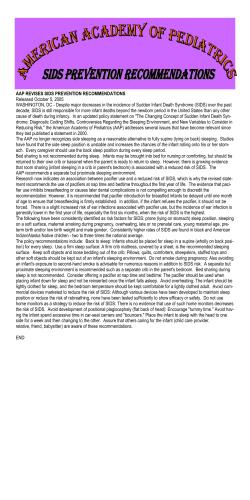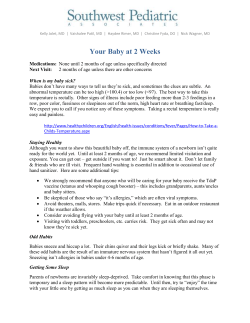
BetterSafe - AbsoluteAdvantage.org
HEALTH BULLETINS BetterSafe WELCOA’S ONLINE BULLETIN FOR YOUR FAMILY’S SAFETY SAFE TO SLEEP SIDS ➤➤ Sleep on or under soft or loose bedding Sudden Infant Death Syndrome (SIDS) is the sudden death of an infant younger than 1 year of age that remains unexplained after a thorough case investigation. This investigation includes performing a complete autopsy, examining the death scene, and reviewing the clinical history. ➤➤ Get too hot during sleep When a baby dies, health care providers, law enforcement personnel, and communities try to find out why. They ask questions, examine the baby, gather information, and run tests. If they can’t find a cause for the death, and if the baby was younger than 1 year old, the medical examiner or coroner will call the death SIDS. ➤➤ Sleep in an adult bed with parents, other children, or pets; this situation is especially dangerous if: If there is still some uncertainty as to the cause after it is determined to be fully unexplained, then the medical examiner or corner might leave the cause of death as “unknown.” ➤➤ Are exposed to cigarette smoke in the womb or in their environment, such as at home, in the car, in the bedroom, or other areas • The adult smokes, has recently had alcohol, or is tired. • The baby is covered by a blanket or quilt. • The baby sleeps with more than one bed-sharer. • The baby is younger than 11 to 14 weeks of age. What Are The Risk Factors? Research shows that several factors put babies at higher risk for SIDS and other sleep-related causes of infant death. Babies are at higher risk for SIDS if they: ➤➤ Sleep on their stomachs ➤➤ Sleep on soft surfaces, such as an adult mattress, couch, or chair or under soft coverings Next Page 17002 Marcy Street, Suite 140 | Omaha, NE 68118 | 402.827.3590 | welcoa.org 1 of 2 HEALTH BULLETINS BetterSafe WELCOA’S ONLINE BULLETIN FOR YOUR FAMILY’S SAFETY Continued from previous page Babies Need Tummy Time! Tummy Time is not only an important way to prevent flat spots on your baby’s head, but it is also an important part of your baby’s normal growth. What Is Tummy Time? Tummy Time describes the times when you place your baby on his or her stomach while your baby is awake and while someone is watching. Tummy Time is important because it: ➤➤ Helps prevent flat spots on the back of your baby’s head ➤➤ Makes neck and shoulder muscles stronger so your baby can start to sit up, crawl, and walk ➤➤ Improves your baby’s motor skills (using muscles to move and complete an action) From the day they come home, babies benefit from 2 to 3 Tummy Time sessions each day for a short period of time (3 to 5 minutes). As the baby grows and shows enjoyment of Tummy Time, you can lengthen the sessions. As babies grow older, more Tummy Time helps build strength for sitting up, rolling over, crawling, and walking. FAST FACTS ABOUT SIDS »» SIDS is the leading cause of death among babies between 1 month and 1 year of age. »» More than 2,000 babies died of SIDS in 2010, the last year for which such statistics are available. »» Most SIDS deaths occur when in babies between 1 month and 4 months of age, and the majority (90%) of SIDS deaths occur before a baby reaches 6 months of age. However SIDS deaths can occur anytime during a baby’s first year. 17002 Marcy Street, Suite 140 | Omaha, NE 68118 »» SIDS is a sudden and silent medical disorder that can happen to an infant who seems healthy. »» SIDS is sometimes called “crib death” or “cot death” because it is associated with the timeframe when the baby is sleeping. Cribs themselves don’t cause SIDS, but the baby’s sleep environment can influence sleep-related causes of death. »» Slightly more boys die of SIDS than do girls. | 402.827.3590 | welcoa.org »» In the past, the number of SIDS deaths seemed to increase during the colder months of the year. But today, the numbers are more evenly spread throughout the calendar year. »» SIDS rates for the United States have dropped steadily since 1994 in all racial and ethnic groups. Thousands of infant lives have been saved, but some ethnic groups are still at higher risk for SIDS. 2 of 2
© Copyright 2024













